The following 5 illustrations describe various ‘stages’ of preparedness of a bolt action sporting rifle routinely encountered in the course of deer management activities.
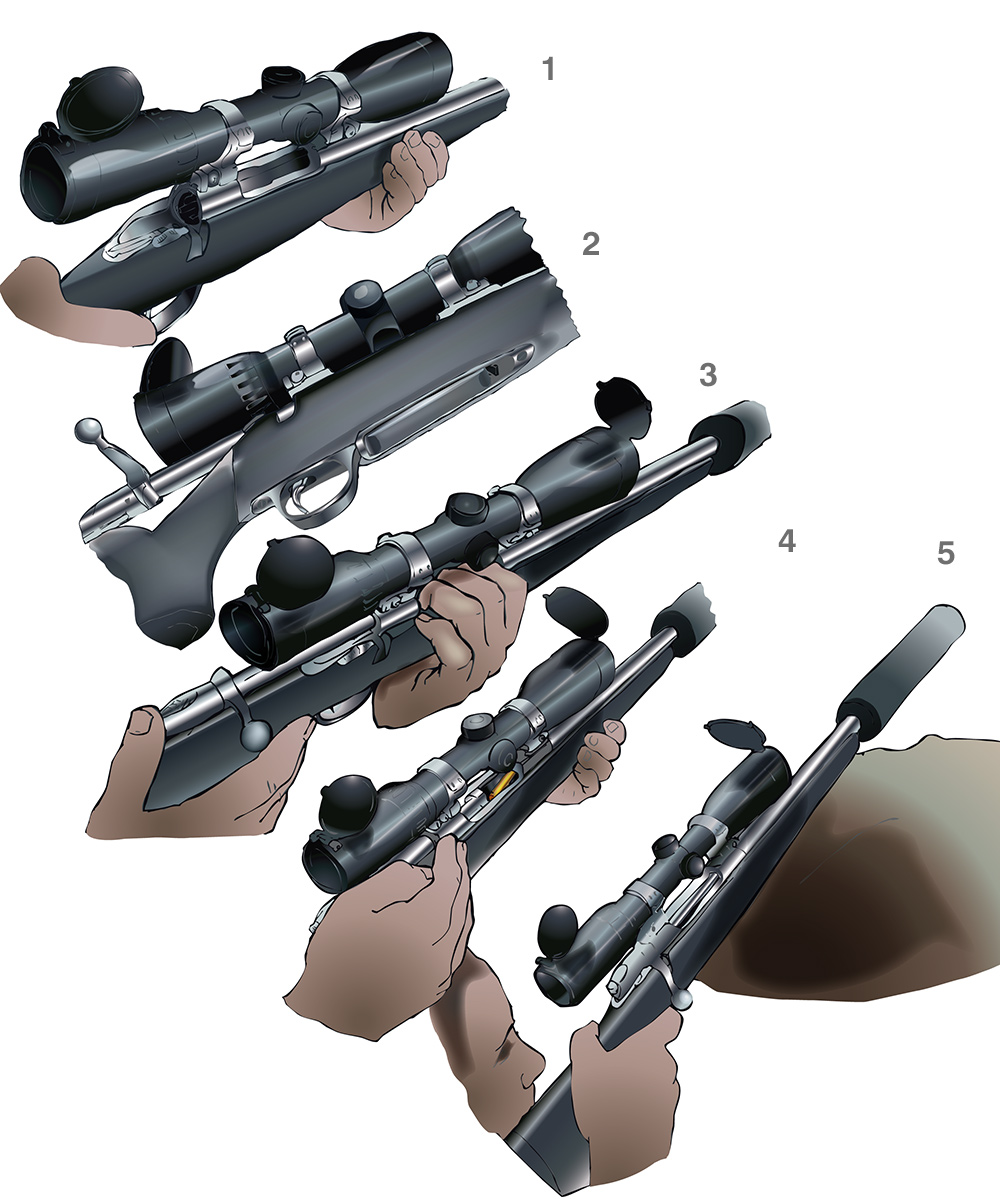
Stage 1: Bolt removed or in place, no rounds in chamber or magazine.
Stage 2: Bolt open, rounds in magazine but not in the chamber.
Stage 3: Bolt closed on empty chamber(fingertip check), safety catch applied, rounds in magazine.
Stage 4: Bolt closed on chambered round, safety catch on (in “safe” position)
Stage 5: Bolt closed on chambered round, safety catch off (in “fire” position)
Risk assessment and Health & Safety
The Health and Safety at Work etc Act 1974 covers the use of firearms by employees and those who “conduct an undertaking” involving the use of firearms1.
- Ensure that an appropriate risk assessment for any activities involving the use of firearms has been carried out and recorded where appropriate*.
Common understanding of terminology
There are a range of scenarios in which deer managers may have learned rifle safety (e.g open-hill stalking, woodland stalking, military, hunting abroad). This means that the terms “loaded” and “unloaded” may mean different things to different people. Inherent to safe use of firearms is the need to be able to describe accurately to others, the location of rounds in relation to the chamber.
- Ensure that you clarify and agree in advance with all members of a group, the words used to describe the status of a rifle at any given time (see status illustrations 1 to 5 above).
When Handling Firearms
- Never allow your firearm to be pointed at anyone.
- Keep the rifle in Stages 1,2 or 3 for as long as possible during the stalk.
- If actively stalking with a rifle in Stage 4, ensure it is kept pointing at the ground or into the sky at all times.
- When crawling forward prior to taking the shot with a rifle in Stage 4, ensure the person in front has control of the rifle to avoid the possibility of accidental discharge when crawling.
- Never rely on a firearms’s safety catch mechanism — it could be faulty or may be accidentally knocked “off”. Periodically check safety catch position if the rifle is in Stage 4.
- Avoid handling firearms while under the influence of alcohol or any drugs.
- Check that the chamber is empty either visually or with finger tip
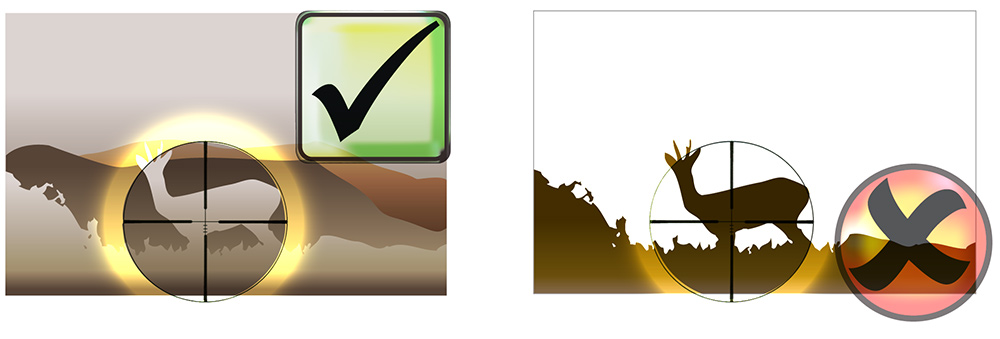
(left) safe, no obstructions in front, no unseen ground between target and solid backstop; (right) skyline shots are never safe because there is no safe backstop

(left) the round, or fragments of the round, may ricochet off the water behind; (right) trees or hedges alone do not make a good backstop, as they may cause ricochet or obscure something you do not mean to shoot at
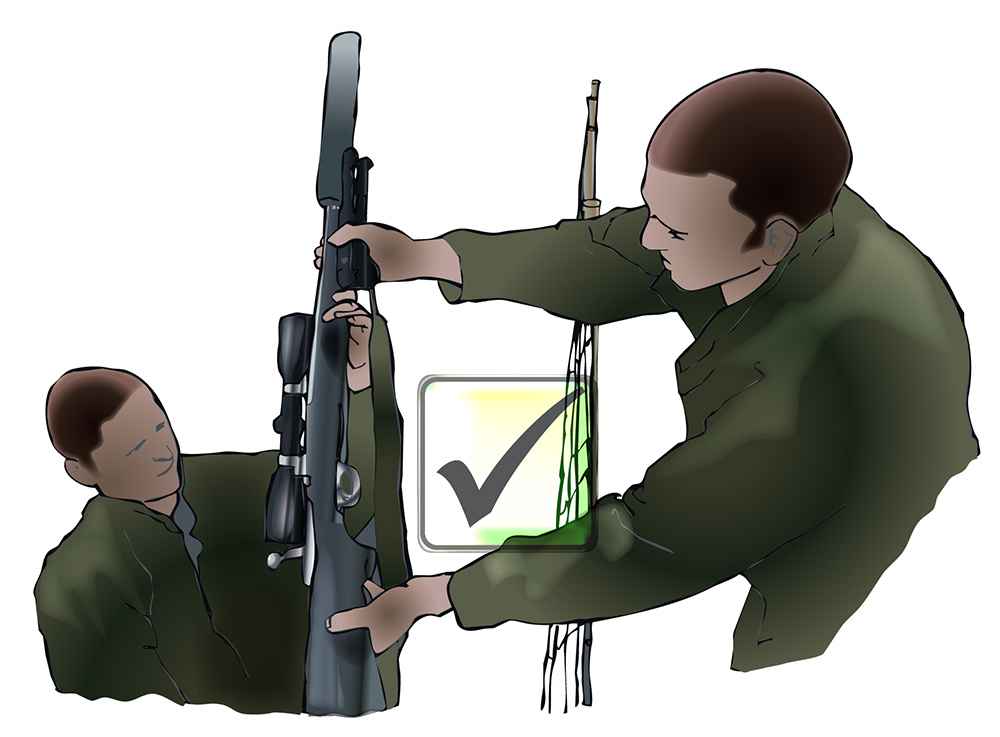
passing over a fence: CORRECTLY ! (note bolt is open)
ALWAYS
- Ensure that the firearm is pointing in a safe direction at all times. i.e so that even if it were to go off it would not cause injury or damage. This should be done:
• Irrespective of load status
• By controlling where the muzzle is pointing at all times
• By handling a firearm at all times as if a round were in the chamber (Stage 4 or 5*). - Know the status of your own and any firearm in your presence at all times.
• Do not be embarrassed to check the status of your firearm and safety catch, or that of others, and do so frequently.
• Inform others in your party of any changes in status.
• Before giving or receiving a firearm make sure that all involved can see that the bolt is open and the chamber is clear(Stage 1 or 2*).
• When moving forward after a shot is taken, make sure the rifleman leads, in case a follow-up shot is required. - Avoid chambering a round (Stage 4 or 5*) until the last possible moment. The time of this will vary for different types of stalking.
• Only disengage the safety catch when just about to take the shot. (Change Stage from 4 to 5*).
• Apply the safety catch as soon as the opportunity for a shot passes.
• If stalking with a rifle with a chambered round (Stage 4*), keep the safety catch applied, and the rifle slung securely over one shoulder.
• If shooting from a vehicle, a round should only be chambered (Stage 4 or 5*) just before a shot is being taken when the muzzle is located outside the vehicle. - Concentrate and remain calm and unhurried when handling firearms
- Ensure that you know how the rifle works and operates. Know
• How the basic parts work
• How to safely open and close the action
• How to disengage a set trigger if fitted
• How to remove rounds from the rifle or magazine - Carry only the correct ammunition for the firearm.
• Ensure this is clean and undamaged
• Carry in a bullet pouch or spare magazine
• After each outing, ensure that all ammunition is accounted for - Ensure the rifle chamber is empty (Stage 1, 2 or 3*) and the Stage of the rifle is known by all present before:
• crossing any major obstacle (.i.e. fence, stream, ditch);
• laying down a firearm e.g to gralloch;
• climbing into a high seat;
• entering a vehicle;
• handing it to another person
It may be acceptable to hand over a rifle with a chambered round and the safety catch on (Stage 4*) for example, before the culmination of a stalk. Ensure that this procedure has been rehearsed with a rifle with no bolt and no rounds in chamber or magazine (Stage 1*). Ensure that the safety catch is on before passing the firearm.
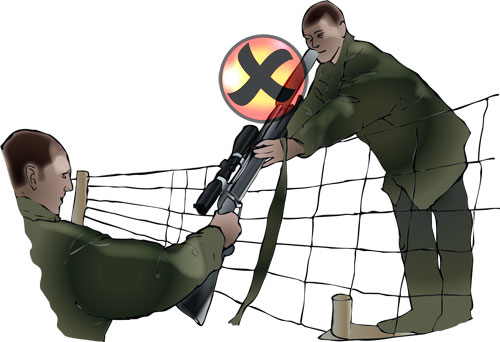
passing over a fence incorrectly
- Before taking a shot:
• Ensure your rifle bore is not blocked and line of fire is free from obstruction. When crawling, a purpose made muzzle cap, or a piece of tape or cling film, is strongly recommended on non-moderated rifles. If the bore becomes obstructed, remove bolt and rounds in the chamber and magazine (Stage 1*) and clean the rifle properly before further use.
• Do not use the scope for spotting before you have started culling.
• Ensure targets have been identified beyond any doubt.
• Ensure targets have a safe backstop.
• Keep your finger off the trigger until ready to fire.
• Put off the safety catch only when in a stable firing position, when the rifle is pointing at the target and when a shot is about to be taken. - Be aware of the dangers of noise.
• Even when sound moderators are in use, seek guidance1 on wearing hearing protection in the presence of firearms.
• Ensure that levels of noise conform to The Control of Noise at Work Regulations 2005 2.
• Ensure that hearing protection is worn where required and that others in close proximity also do so. - Ensure the firearm is safe to operate through regular maintenance **
- In the case of a misfire, keep the muzzle pointing in a safe direction until it has been made safe. Open the chamber, keeping your face and body away from the chamber port. Lift the bolt swiftly and cleanly upwards by the fingertips, minimising any exposed body parts to any blast from the chamber port.
- Ensure that firearms are securely stored when not in use or when being transported to prevent access by unauthorised persons. Rifles should be stored and transported with the bolt removed and no rounds in the chamber or magazine (Stage 1*).
- Ensure that the bolt and rounds in the chamber and magazine have been removed from the rifle (Stage 1*) before entering a building.
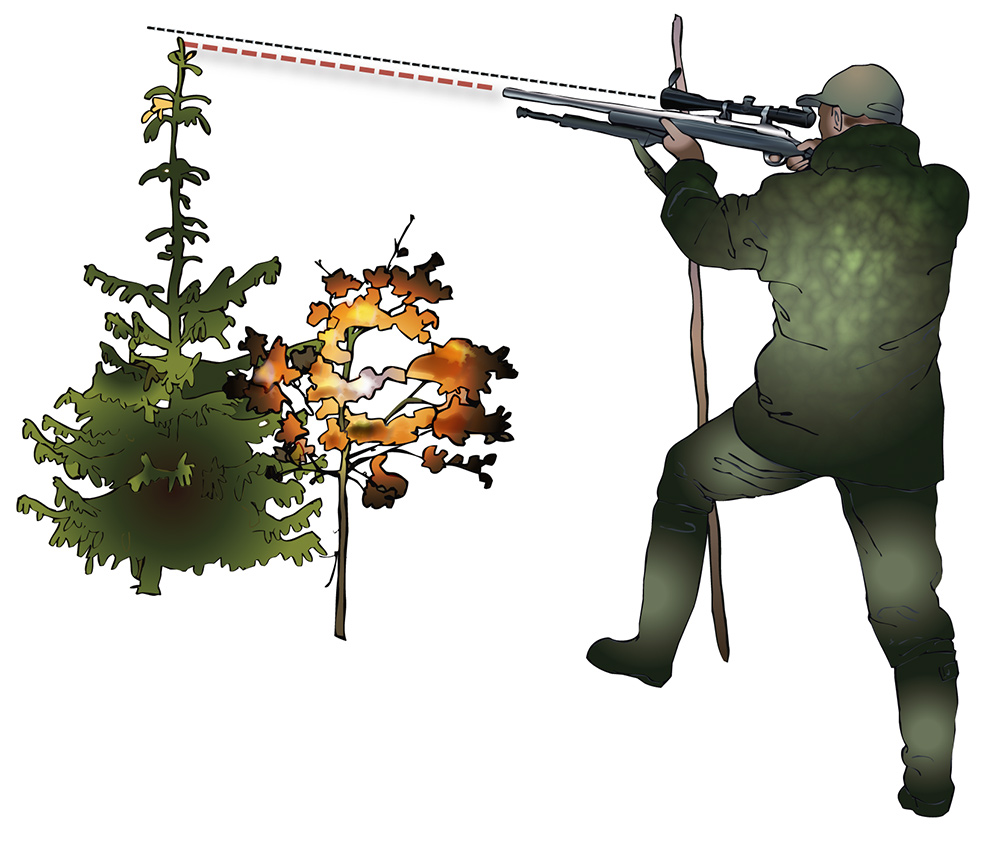
avoid obstructions to the bullet path; note that the top (black dotted) line is the line of sight, whilst the lower (red dashed) line is the actual bullet path

the sightline of this shot sees over the boulder, whilst the line of the bullet clips into it
2The Control of Noise at Work Regulations 2005. available on-line at OPSI or from the The Stationery Office Limited (see BP Contacts).
